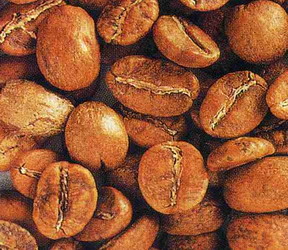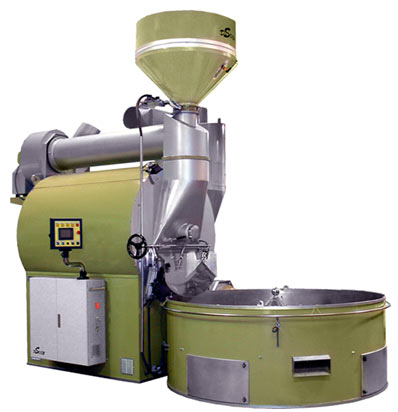Roasting techniques of Coffee Bean treatment: coffee Bean Baking Theory (1) detailed introduction
(reprinted)
Grab a handful of coffee raw beans smell, there is always a pungent smell, very different from the impression of the charming smell of coffee. However, after roasting "fragrance" correctly, raw beans will emit the strongest aroma in the world.
The small, high-altitude raw Arabica coffee beans are like a warehouse full of chemicals. At present, scientists have identified more than 2, 000 known ingredients, of which 70 to 850 are aromatic ingredients, which can be called the most fragrant in the human diet. There are only 150 kinds of vanilla used for seasoning in the catering industry, and the mellow composition of wine is not nearly as rich as coffee.
Roasting awakens fragrant elves however, the 700 or 800 fragrant "elves" contained in raw coffee beans will not come out on their own, but must be "awakened" by professional baking. Without this procedure, coffee can only be tasted in the sun or washed in water, and it smells uncomfortable, let alone drink it. After five to 25 minutes of heating, the chemical composition of raw beans has undergone drastic changes, giving off a rare fragrance in the human world. This complex chemical reaction cannot be simulated even in today's most sophisticated laboratories, but it can probably be summed up into several key items.
First of all, after baking raw beans at more than 200 degrees Celsius, the moisture begins to evaporate, the volume expands by 60%, and the weight is reduced by 10% to 25. Depending on the degree of baking, the deeper the baking, the greater the weight loss. No wonder many operators do not like re-baking to save costs. Another important phenomenon is exhaust. Raw beans release carbon dioxide during baking and will continue to exhaust for 30 days after baking. Interestingly, carbon dioxide emissions contribute to the preservation of coffee beans, because during the exhaust process, oxygen molecules are not easy to invade, that is, the oxidation that destroys the flavor of coffee cannot be carried out, but the exhaust gradually slows down after seven days of baking. Oxygen molecules are easily attached to the bean surface, and the flavor of coffee decays quickly, which is an important reason why coffee beans are best used within a week after opening.
The secret of baking: get the highest caramel and least carbonization. Caramelization is a link that has the greatest impact on the flavor of coffee. After six to seven minutes of baking, raw beans absorb a lot of heat and start the pyrolysis reaction, resulting in the first explosive sound. Some sugars are converted into carbon dioxide, and water continues to evaporate. New aromatic components gradually develop into the so-called coffee oil. And combine with hundreds of aromatic substances such as nicotinic acid, citric acid, quinic acid, malic acid, acetic acid, caffeine and so on. Pyrolysis reaction can continue to the second explosion, although caramelization is an important process to awaken aromatic elves, but with the extension of baking time, some ingredients will also be carbonized to form a bad astringent bitter substance, how to obtain the highest caramelization, but also to minimize carbonization, which seems to be contradictory, but it is the biggest challenge for bakers.
Pay attention to the changes in sound, color and taste. The above chemical reactions can be judged by listening to the sound, seeing the color and smelling the smell. As the color of coffee beans continues to heat up, the color of coffee beans will change from gray to golden yellow to light brown, then to a trace of reddish brown of oil, and then a large amount of oil will show a dark brown of oil. if it goes on baking, the coffee oil on the bean surface will become dry and dead black. and emit a lot of blue smoke, sandwiched with a scorching smell, this is a warning that is close to the burning point. Prepare to call 119 to help put out the fire. Experienced bakers will choose between light brown to oily dark brown for safety. Coffee beans change from shallow to deep because of changes in caramelization and acidity.
Listening to sound is also the basis for judging the degree of baking. If the temperature of the roaster is hot enough, coffee beans will burst twice during the roasting process. For example, high-temperature-resistant raw beans such as Mantenin and Angelica will burst for the first time in about seven minutes, and the sound will be low and sparse. This means that the "pyrolysis" is started, that is, the starch begins to be converted into caramel, and water is ejected from the bean surface with carbon dioxide, making a low burst sound, which is quiet for two minutes. At about 12 minutes, there was a more violent and sharp burst, which was the sound of broken fibers in coffee beans, which indicated that the baking was coming to an end, and the fragrance would fade if it went on. We can see that coffee beans can talk.
Source:
The blog of the coffee wizard
Important Notice :
前街咖啡 FrontStreet Coffee has moved to new addredd:
FrontStreet Coffee Address: 315,Donghua East Road,GuangZhou
Tel:020 38364473
- Prev

Coffee bean processing method Roasting technology skills: Coffee bean roasting degree introduction
The taste of coffee depends mainly on the roast, generally lighter roast will have a brighter sour, darker roast will have a stronger bitter, this is the basic rule. The depth of roasting depends mainly on the characteristics of raw beans, personal preferences and other factors, the most important thing is the balance of bitterness and sourness. Baking can be divided into light, medium, dark and very dark baking.
- Next

Roasting techniques for the treatment of raw coffee beans: coffee bean roasting theory (3) detailed introduction
In addition to the degree of baking is divided into factions, even the roaster also has a family view. At present, there are two major professional roasters, one is the traditional rolling furnace (Drum Roaster), and the other is the newly developed hot gas furnace (Air Roaster). The former is heated by gas across the bottom of the furnace, while the metal blades in the furnace keep stirring the beans, while the latter bakes the beans with high-temperature hot air flow.
Related
- What is the meaning of lactic acid fermentation with coffee bean treatment?
- How to judge the state of foam by sound?
- How does the latte pull out the unicorn pattern? Come to get for a little trick to improve the flower pull!
- Will flower pulling affect the taste of the latte?
- Do you know the history of coffee?
- The difference between honey treatment and sun washing what is raisin honey treatment?
- What kind of milk can a novice use to make coffee foam to keep the foam longer? The correct method and skills of milking tutorial sharing
- Why do washed coffee beans taste sour? Flavor characteristics of washed Coffee
- Introduction to the skill of how to practice the size and height of water injection around the circle of hand-brewed coffee
- How do beginners practice coffee flower drawing from scratch?

